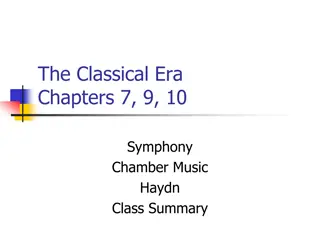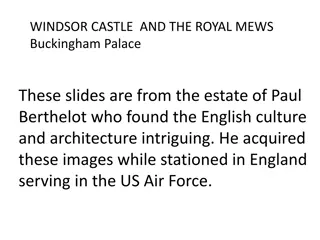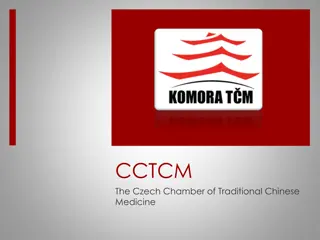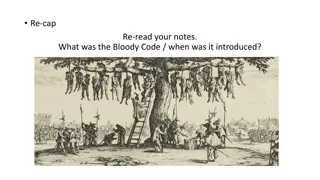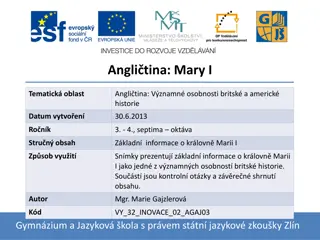Angela Carter and The Bloody Chamber
Angela Carter, a bold and original 20th-century writer, explored themes from gothic fantasy to feminism. Her work, like "The Bloody Chamber and Other Stories," delves into provocative storytelling with elements of graphic content. Dive into her captivating life and literary contributions that challenge traditional norms and offer a unique perspective on classic tales.
Download Presentation

Please find below an Image/Link to download the presentation.
The content on the website is provided AS IS for your information and personal use only. It may not be sold, licensed, or shared on other websites without obtaining consent from the author. Download presentation by click this link. If you encounter any issues during the download, it is possible that the publisher has removed the file from their server.
E N D
Presentation Transcript
ANGELA CARTER THE BLOODY CHAMBER AND OTHER STORIES Plot summary, Characters, Themes, and Symbols
ANGELA CARTER Biography
Angela Carter (1940 1992) is one of the boldest and most original writers of the 20th century. Her work draws on an eclectic range of themes and influences, from gothic fantasy, traditional fairy tales, Shakespeare and music hall, through Surrealism and the cinema of Godard and Fellini. Carter s work breaks many long-established taboos and mores. Her perfectly crafted stories are often provocative and subversive and many contain graphic and violent content.
She was born Angela Olive Stalker Angela Olive Stalker in 1940 in Eastbourne. Much of her childhood was spent with her grandmother in Yorkshire, where she was sent to escape wartime bombing. After the war, she went to school in Balham, south London. Trips with her father to the Granada Cinema in Tooting instigated a life-long love of cinema and film which features strongly throughout her work. On leaving school, she worked briefly at the Croydon Advertiser before she married Paul Carter in 1960 and moved to Bristol where she studied English at Bristol University, specialising in medieval literature.
Her first novel, Shadow Dance was published in 1966 and quickly followed by The Magic Toyshop (1967) and Several Perceptions (1968), which won the Somerset Maugham award. These early novels are heavily imbued with elements of gothic fantasy and horror. In 1967 Carter began writing her distinctive, often acerbic, essays for New Society magazine and continued the collaboration for 20 years, her essays being collected firstly in Nothing Sacred (1982), in Expletives Deleted (1992) and, together with her other journalism, after her death, in Shaking a Leg (1997). A condition of the Somerset Maugham award was that it be used for foreign travel and in 1969 Carter travelled to Japan.
Japanese culture had a huge impact on Carter. She wrote some powerful essays during her Japan years, and her experiences also inspired her collection of semi- autobiographical short stories, Fireworks (1974). Her novels Heroes and Villains (1969) and The Infernal Desire Machines of Dr Hoffman (1972) both written in Japan together with The Passion of New Eve (1977) signalled a change of direction towards a sinister form of science fiction. Carter s controversial work of cultural analysis, The Sadeian Woman (1979) also has its roots in her experiences in Japan where her experiences of working in hostess bars intensified her feminism.
Published the same year as The Sadeian Woman, Carter s The Bloody Chamber (1979) was one of her most successful books. Carter finely draws out the latent sexual and violent content of the traditional tales of Bluebeard s castle and Red Riding Hood, creating a collection of new fiercely subversive tales. In the mid-1970s, Carter settled in south London again and got together with Mark Pearce, with whom she had a son, Alexander, in 1983. During the late 1970s and 80s, Carter taught at a number of universities; including Sheffield and East Anglia in Britain, Brown in the US and the University of Adelaide in Australia.
Her novel, Nights at the Circus (1984), won the James Tait Black Memorial Prize and in 2012 was declared the best book to have ever been awarded that prize. Her last novel Wise Children (1991), tells the story of twin chorus girls Dora and Nora Chance and their bizarre family, bringing together high and low culture, with elements of music hall and Shakespeare. After Angela Carter s death from lung cancer in 1992, interest in her work suddenly increased, with a rapid rise in sales of her books and a plethora of stage adaptations of her work in Britain and abroad. Her writing occupies a unique place in 20th century fiction, a place where myths around gender and sexuality are debunked and where not even the deepest darkest recesses of human imagination are off-limits.
THE BLOODY CHAMBER Plot Summary
In The Bloody Chamber the heroine, a young pianist, marries a rich Marquis who had three earlier wives. The heroine moves to the Marquis castle, where she loses her virginity and finds a collection of sadistic pornography. The Marquis then gets a business call and leaves, entrusting his keys to the heroine and only forbidding her from one room. He leaves and the heroine uses the forbidden key, which leads to a torture chamber torture chamber containing the bodies of the Marquis three previous wives.
The heroine tells a young piano tuner what she saw and then the Marquis returns. The Marquis learns what the heroine did and prepares to behead her. Just as he swings his sword the heroine s mother appears and shoots the Marquis. The heroine inherits the Marquis fortune and she, her mother, and the piano tuner live happily together.
In The Courtship of Mr Lyon, Beauty s father seeks refuge from a snowstorm at an empty mansion. On his way out he takes a white rose like Beast appears. rose and then the lion- The Beast makes Beauty come to dinner, where the Beast asks her to stay with him, promising that her father s fortunes will be restored. Beauty agrees, and she spends the days alone and the nights talking with the Beast. When her father grows rich she leaves, promising to return before winter ends. Beauty forgets her promise and only returns when the Beast is dying. She finds him in his bed and kisses his hands, and he turns into a man.
In The Tiger s Bride a Russian man gambles away his daughter to a mysterious nobleman called The Beast. The Beast s valet takes the heroine to a mansion, where The Beast wants to see her naked. The heroine refuses and is put in a room with an automaton maid. T he Beast then takes the heroine on a horse ride, where he disrobes and reveals himself as a tiger. The heroine takes off her own clothes in response. Later the heroine goes to the tiger s room, where he licks her and her skin comes off as she transforms into a tiger.
In Puss-in-Boots, Figaro is a clever cat whose young, promiscuous master falls in love. His desire is the young, closely-guarded wife of Signor Panteleone. Figaro cleverly unites the two lovers and he himself falls for the woman s tabby cat. Eventually the tabby trips Panteleone so he falls to his death, and Figaro s master and the young woman have sex next to Panteleone s body and then get married. In The Erl-King, the heroine wanders into the woods and is seduced by the Erl- King, a mysterious figure who lives in harmony with nature and has many birds in cages. The heroine learns that the caged birds were once girls, and she strangles the Erl- King and sets the birds free.
In The Snow Child, a Count creates a girl out of his wishes, but she pricks herself on a rose thorn and dies. He then has sex with her body, melting it. In The Lady of the House of Love, a young soldier is lured into the mansion of the Countess, a beautiful girl vampire. The Countess cuts herself on some glass as she prepares to seduce and kill the young man, and he kisses her wound, making her become mortal and die. He takes a rose from her and goes off to war. In The Werewolf a child travels through the forest to visit her grandmother. She is attacked by a wolf and cuts off its hand. When she reaches her grandmother s house she finds that her grandmother is missing a hand, so the neighbors kill the grandmother.
In The Company of Wolves a child goes to visit her grandmother and meets a handsome huntsman on the way. The huntsman gets to the grandmother s house first, transforms into a wolf, and eats the grandmother. The child arrives and seduces the wolf before he can eat her. Wolf Wolf- -Alice her in but then give her to a werewolf Duke is wounded by a bullet and then Wolf-Alice licks his wound, transforming him into a full human. Alice is a girl raised by wolves. Some nuns take Duke. The Duke
THE BLOODY CHAMBER Characters
Heroine (The Bloody Chamber) Heroine (The Bloody Chamber) A young, virginal pianist who lives with her mother and then marries the sadistic Marquis. After she discover the Marquis torture chamber he threatens to behead her, but she is saved by her mother. Later she marries Jean-Yves. The Marquis The Marquis The richest man in France, a huge, bearded nobleman who collects sadistic pornography and murders his wives in the bloody chamber of his seaside castle. He is killed by the heroine s mother. Jean Jean- -Yves Yves A young, blind piano tuner who befriends the heroine and tries to protect her from the Marquis. Later the heroine marries him.
Heroine s Mother Heroine s Mother A fierce, independent woman who had fought pirates and killed a tiger in her youth, and married a poor soldier. She saves the heroine at the story s climax. Housekeeper Housekeeper An old woman who tends to the Marquis castle with a strict routine, and was the Marquis foster mother growing up. The Model The Model The Marquis second wife, the model for an engraving by Odilon Redon called The Evening Star Walking on the Rim of Night. Her skull hangs suspended in the bloody chamber.
The Opera Singer The Opera Singer The Marquis first wife. The heroine saw her singing the part of Isolde in the opera Tristan. The Romanian Countess The Romanian Countess The Marquis third wife, a clever, beautiful woman who he kills with the Iron Maiden. The Beast (The Courtship of Mr. Lyon) The Beast (The Courtship of Mr. Lyon) A lion-like creature who lives in a mansion and is attended to by the spaniel. He falls in love with Beauty and is transformed into a man, Mr Lyon, by her kiss.
Beauty Beauty A brave, beautiful girl who falls in love with the Beast but then is distracted by her father s newfound wealth. Beauty s Father Beauty s Father A man who lost his fortune and so lives in poverty. He finds the Beast s mansion during a snowstorm and is the beneficiary of the Beast s hospitality. The Spaniel The Spaniel The Beast s attendant, an intelligent dog with a diamond-studded collar.
The Beast (The Tiger's Bride) The Beast (The Tiger's Bride) A tiger who disguises himself as a man with a mask and cloak. He lives in an isolated mansion and plays cards with everyone who passes through his town. Heroine (The Tiger's Bride) Heroine (The Tiger's Bride) A beautiful, virginal girl whose father gambles her away to The Beast. At first she refuses The Beast and threatens to kill herself, but then she undresses before him and is transformed into a tiger by his kiss. Heroine s Father Heroine s Father A wasteful, foolish man who gambles away his fortunes and his daughter and tries to tearfully apologize.
Valet Valet A monkey disguised as a man who attends to The Beast. Maid Maid An automaton that looks exactly like the heroine and attends to her in her bedroom. Figaro Figaro A clever, roguish cat who wears boots and helps his master cheat people out of money and seduce women. Later he settles down with the tabby.
Master Master Figaro s companion, a clever, promiscuous young man who falls in love with Signor Panteleone s wife and later marries her. Young Woman Young Woman Signor Panteleone s young wife, a virgin because her husband is impotent. She is seduced by Figaro s master and marries him immediately after Signor Panteleone dies. Hag Hag A mean old woman who guards the young woman and is allergic to cats.
Signor Panteleone Signor Panteleone A rich old miser who guards his young wife as a prize possession. He trips over the tabby, falls down the stairs, and dies. Tabby Tabby Signor Panteleone s cat, a clever schemer who helps unite the master and the young woman. Figaro falls in love with her. The Erl The Erl- -King King A mysterious green-eyed figure who lives in the forest and communes with the animals. He lures girls in with his pipe and seduces them, and then turns them into birds and puts them in cages.
Heroine (The Erl Heroine (The Erl- -King) King) A young woman who wanders into the forest and is seduced by the Erl-King. She strangles him with his own hair. The Count The Count He creates a girl out of his own desires and then has sex with her corpse when she dies. The Countess (The Snow Child) The Countess (The Snow Child) The Count s wife who is jealous of the girl.
Girl Girl A magical girl created from blood, snow, and a raven s feather. She gets pricked by a rose and dies. The Countess (The Lady of the House of Love) The Countess (The Lady of the House of Love) The queen of vampires, a beautiful young girl who lives in a mansion in Romania and feeds on rabbits and passing travelers. She constantly lays out Tarot cards. Governess Governess A mute old woman who attends to the Countess and leads unsuspecting travelers to her room.
Young Man (The Lady of the House of Love) Young Man (The Lady of the House of Love) A young, virginal British soldier traveling through Romania on his bicycle. He inadvertently kills the Countess with his kiss, and afterward is called off to fight in WWI. Child (The Werewolf) Child (The Werewolf) A brave young girl who cuts off a wolf s hand when it attacks her, and then helps kill her grandmother when the grandmother revealed as a werewolf. Grandmother Grandmother A werewolf who is discovered by her granddaughter and stoned to death.
Child (The Company of Wolves) Child (The Company of Wolves) A sheltered, virginal girl who goes to visit her grandmother. She encounters a huntsman werewolf and seduces him before he can eat her. Huntsman Huntsman A werewolf who appears first as a handsome huntsman. He eats the child s grandmother and is seduced by the child. Grandmother Grandmother A pious old woman who is eaten by the wolf.
Wolf Wolf- -Alice Alice A feral girl who was raised by wolves. She is taken in by some nuns who try to civilize her, but then given up to the Duke. The Duke The Duke An old, monstrous werewolf who feeds on humans and doesn t appear in mirrors. Young Man (Wolf Young Man (Wolf- -Alice) Alice) A bridegroom whose bride was killed by the Duke. He shoots the Duke with a silver bullet.
THE BLOODY CHAMBER Themes
Sexuality and Sexuality and Violence Violence Angela Carter was influenced by the writings of the Marquis de Sade in the writing of The Bloody Chamber, and she especially illustrates his idea that sex is often inextricably linked with violence. The most potent example of this is in the title story, The Bloody Chamber, where the Marquis has a collection of violent pornography and a chamber where he tortures his wives. The virginal heroine allows herself to be corrupted by the Marquis and loses her sexual innocence, demonstrating one of Carter s more controversial ideas that women can take part in the sexual violence that oppresses them and in the bloody chamber the heroine gains the knowledge that her new sexual freedom will lead to her violent death. All the other stories also involve some link between sex and violence, like Figaro s master having sex with the young woman next to Signor Panteleone s body, or the wolf trying to eat Little Red Riding Hood but being seduced by her instead (next to her grandmother s body). The violence Carter associates with sex and sexual awakening often leads to objectification and manipulation as well. Even in a happy ending like that of The Company of Wolves or The Tiger s Bride, sexual freedom only comes at the price of some kind of pain. This recurring theme results in the very gothic, sensual tone of the stories as they show how fairy tales portray the darker side of human desire.
Virginity Virginity Related to the principle theme of sexuality is the idea of virginity, and many of the heroines (and one hero) of the stories are virgins. In the world of The Bloody Chamber, virginity is both an invitation for corruption and a kind of strength or shield. In the stories that focus on sexual violence and manipulation (like The Bloody Chamber or The Tiger s Bride ) the virginity of the heroines is their most attractive quality to the bestial men who desire them. Though virginity inherently means a kind of innocence, in Carter s stories it has a unique strength as well. Twice she describes a character s virginity as like a pentacle protecting them from harm, and she illustrates the power of virginity as the power of potential, like a stone about to fall. In several stories, when the heroine loses her virginity this act also releases a kind of transformative power that is more than sexual often a kind of metamorphosis. Throughout the book virginity is like the blank slate, the potential for sexual violence, a metamorphosis of the self, or both.
Metamorphosis Metamorphosis Many of the characters of The Bloody Chamber are creatures who are half-human and half-beast, or else undergo some change from beast to human or vice versa. These creatures, like The Beast, the Erl-King, and the huntsman werewolf, exist in an in- between space in the world, neither fully human nor fully non-human. They are the traditional creatures of the ancient fairy tales, but Carter also links their kind of life on the threshold with the sexual awakening and loss of virginity that most of the stories heroines experience. So Mr Lyon is transformed from beast to human by the heroine s love, while the heroine of The Tiger s Bride is transformed into a tiger. These fantastic metamorphoses as part of sexuality and virginity then lead to Carter s more subtle point that even the women who experience no magic metamorphosis (like the young woman of Puss-in-Boots ) still live on a kind of threshold, treated as both humans and objects (of sexual desire, usually). It is only through some kind of extreme action like the young woman colluding in Signor Panteleone s death to escape him that the heroines can cross the threshold and become fully human.
Power and Power and Objectification Objectification The book s sexual violence and Carter s feminist worldview create a theme of manipulative power and the objectification of women. This is part of the latent content that Carter tried to expose in the old fairy tales. In most of the original stories there is already a divide between a poor, virginal heroine and a wealthy, powerful man/monster, but in Carter s versions this divide also leads to sexual oppression. These archetypes of victim and victimizer lead many of the stories to the stark objectification of a woman, usually through a scene where the woman is naked and the man/beast is clothed. This pornographic image, like the sadistic pictures the Marquis collects in The Bloody Chamber, is the ultimate example of the woman as object and the man as powerful manipulator. While in these situations the women seem totally objectified and powerless, in Carter s stories they can also gain an agency of their own, like the heroine killing the Erl-King and escaping his power. Instead of rejecting the old fairy tales for their objectification of women and sexual violence, Carter retells them from a female point of view, giving the stories heroines greater agency in their fates.
THE BLOODY CHAMBER Symbols
Bloody Bloody Chambers Chambers Each of the book s ten tales contains some kind of bloody chamber, though the most obvious is the torture room of the titular story. The bloody chamber is a place of both violence and enlightenment, as the first heroine discovers the true nature of her husband s desires and her own inevitable fate in this room. Other bloody chambers include the Beast s room in The Tiger s Bride, the blood-filled hole in The Snow Child, and the grandmother s house in The Werewolf and The Company of Wolves. The combination of violence and enlightenment in these places usually takes a sexual form, as in the first bloody chamber the torture is part of the Marquis sadistic desires. Because of this, the bloody chambers of the book act as symbols of a woman s vagina or womb, and the blood is associated with menstruation or the loss of virginity. Throughout the stories Carter associates sexual awakening with violence, but also with a kind of enlightenment or transformation. Thus the bloody chamber of a woman s body becomes the site of both oppression and metamorphosis.
Roses Roses Roses appear in most of the stories of The Bloody Chamber, and they generally symbolize the female heroine of each tale. The rose is a traditional romantic image, a symbol of female purity and the vagina, and the repetitive use of the rose image reflects the book s gothic tone and archetypal characters. The rose as a symbol of femininity becomes more complex in Carter s stories, however, as it initially acts as a sign of virginity and purity but the very act of symbolizing then becomes a symbol of objectification. When the women of the book are objectified by male power and sexual oppression, they have no more agency than a beautiful but powerless rose. In The Tiger s Bride and The Snow Child, however, the thorns of the rose prick the heroine s finger. This shows the suffering brought about by being objectified (usually through sexual violence), but it also implies some agency in the heroines themselves. They are symbolized by the pure, beautiful rose, but they also have thorns and can bite.
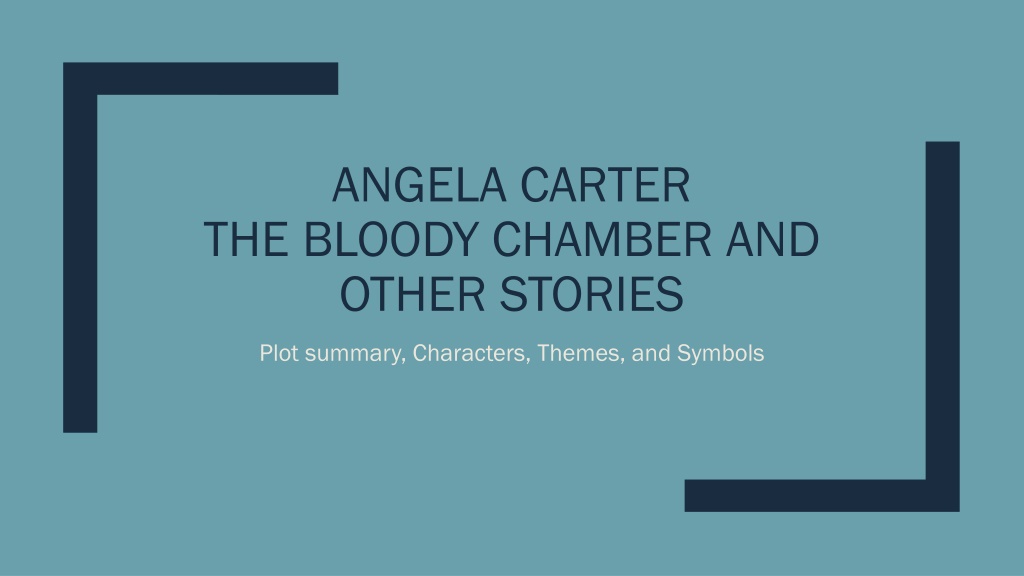
 undefined
undefined
 undefined
undefined








